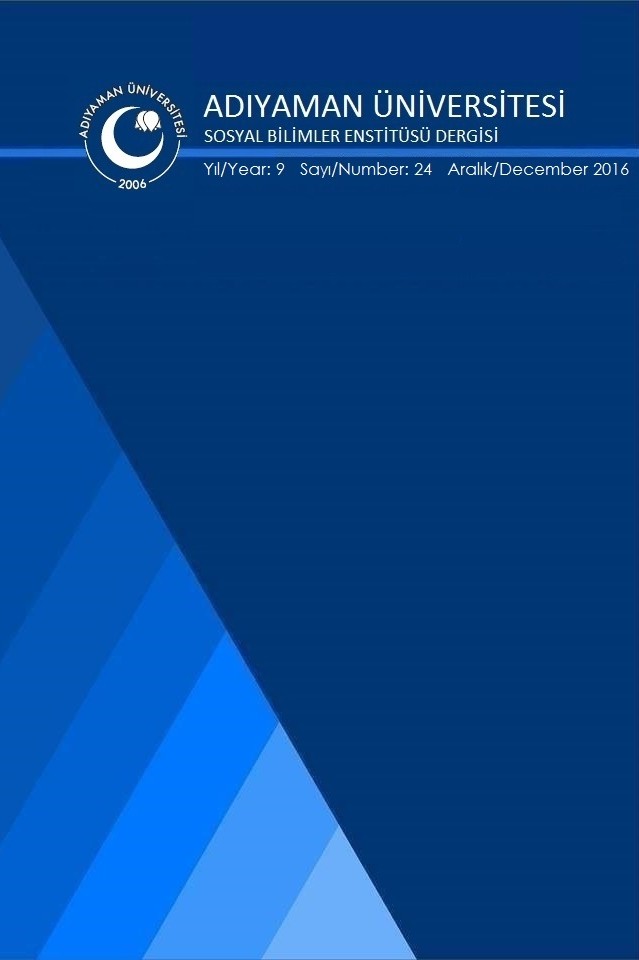YÜKSEKÖĞRETİM’DE ÖĞRENME DENEYİMİNİN ÖĞRENCİ GÖRÜŞLERİNE GÖRE DEĞERLENDİRİLMESİ: COĞRAFYA EĞİTİMİ ÖRNEĞİ
Son yıllarda yükseköğretimdeki hem araştırma hem de eğitim-öğretim süreçlerine yönelik kalite beklentisinin artması bu alana yönelik araştırmalarda özellikle Batılı ülkelerde yoğun bir artış olduğunu göstermektedir. Bu araştırmalar içerisinde üniversitelerde Coğrafya eğitimi alan bireylerin öğrenme stillerine yönelik araştırmaların hem ulusal hem de uluslararası çalışmalara konu olduğu görülmektedir. Buna rağmen, öğrencilerin öğrenme stilleri ile deneyimleri arasındaki ilişkinin görece zayıf bir düzeyde ele alındığı fark edilmektedir. Bu araştırma, öğrencilerin Coğrafya eğitimindeki öğrenme deneyimlerine yönelik eleştirel bir değerlendirme yapmayı amaçlamaktadır. Bu doğrultuda saygın bir üniversitemizin Coğrafya programında eğitim gören 346 öğrenciye yönelik bir anket uygulaması gerçekleştirilmiştir. Araştırmanın temel bulguları arasında ise öğrenme stilleri ile öğrencilerin deneyim beklentilerinin karşılanması noktasında bir uyumsuzluk olduğu ortaya çıkmaktadır. Diğer taraftan ise baskın öğrenme özelliği olarak ‘Özümseme’ stilini benimseyen öğrencilerin ise, sayıları az da olsa, mevcut deneyimleriyle daha iyi öğrendiklerini ifade etmektedirler ve mevcut deneyimlerinin kendilerinin daha iyi öğrenmesine yol açtığını göstermektedir. Araştırma literatürdeki çalışmaları ve mevcut bulguları eleştirel bir çerçevede ele alan bir tartışma bölümü ile sona ermektedir.
___
Akin, H. B.,& Senturk, E. (2012). “Bireylerin mutluluk düzeylerinin ordinal lojistik regresyon analizi ile incelenmesi” [Analysing individuals’ levels of understanding of ordinal regression analysis]. Öneri Dergisi, 10: 183-193.Ashwin, P. (2005). The development of learning and teaching: The changing context. In Changing higher education: The development of teaching and learning (Ed. Ashwin, P. ). Oxon: Routledge.
Bassey, M. (1999). Case study research in educational settings. McGraw-Hill Education (UK).
Beard, R. M. (1968). Objectives in Higher Education. London: Society for Research into Higher Education (SRHE).
BIS (2009). Higher Ambitions: The future of universities in a knowledge economy. London: The Department for Business.
Biggs, J. B. & Tang, c. 1999. Teaching for quality learning at university (First edition). Berkshire: Open university press.
Biggs, J. B. & Tang, c. 2009. Teaching for quality learning at university (3rd edition). Berkshire: Open University Press.
Boud, D. J. (2006). 'Aren't we all learner-centred now?'The bittersweet flavour of success. Changing higher education: The development of learning and teaching. Oxon: Routledge.
Bradbeer, J., Healey, M., & Kneale, P. (2004). Undergraduate geographers' understandings of geography, learning and teaching: a phenomenographic study. Journal of Geography in Higher Education, 28(1), 17-34.
Cohen L. , Manion L. and Morrison K. (2007). Research methods in education (6th edition). London: Routledge Falmer.
Cousin G. (2005). “Case study research”. Journal of Geography in Higher Education. 29(3): 421-427.
EU, 2015, Erasmus+ Projeleri (http://ec.europa.eu/programmes/erasmus-plus/, Erişim tarihi: 01.12.2015).
Geçit, Y., & Delihasan, S. (2014). “Learning Styles of Candidates of Geography Teaching”. Procedia-Social and Behavioral Sciences, 120, 621-628.
Gencel, İ. E. (2007). “Kolb'un deneyimsel öğrenme kuramına dayalı öğrenme stilleri envanteri-III'ü Türkçeye uyarlama çalışması”. Dokuz Eylül Üniversitesi, Sosyal Bilimler Enstitüsü Dergisi. 9(2), 120-139.
Haigh, M. 2012. “Writing Successfully for the Journal of Geography in Higher Education”. Journal of Geography in Higher Education. 37(1), 117-135.
Harvey, L., & Green, D. (1993). “Defining quality”. Assessment & Evaluation in Higher Education. 18(1), 9-34.
Healey, M., & Jenkins, A. (2000). “Kolb's experiential learning theory and its application in geography in higher education”. Journal of Geography, 99(5), 185-195.
Healey, M., Kneale, P., & Bradbeer, J. (2005). “Learning styles among geography undergraduates: an international comparison”. Area, 37(1), 30-42.
Kent, M., Gilbertson, D. D., & Hunt, C. O. (1997). “Fieldwork in geography teaching: A critical review of the literature and approaches”. Journal of Geography in Higher Education, 21(3): 313-332.
Kolb, A. Y., & Kolb, D. A. (2005). “Learning styles and learning spaces: Enhancing experiential learning in higher education”. Academy of management learning & education, 4(2), 193-212.
Kolb, D. A. (1999). The kolb learning style inventory. Hay Resources Direct.
Laurillard, D. (2006). E-learning in higher education. Changing higher education: The development of learning and teaching, 71-84. Oxon: Routledge.
Kolb, D. (1985). Learning styles inventory. Englewood Cliffs, N.J.: Prentice-Hall. USA.
MacKenzie, N. (1970). Teaching and Learning. An Introduction to New Methods and Resources in Higher Education.
Marton, F. & Saljo, R. (1976). “Learning processes and strategies: II. On qualitative differences in learning: II. Outcome as a function of the learner's conception of the task”. British Journal of Educational Psychology, 46(1): 115-127.
Healey, M. (2000). “Developing the scholarship of teaching in higher education: a discipline-based approach”. Higher Education Research and Development, 19(2): 169-189.
Özdemir, N. (2015). “A Comparative Study Regarding the Learning Styles Of Turkish Undergraduate Geography Students And Theır Western Counterparts”. Firat University Journal of Social Sciences, 25(1):71-88.
Prosser, M., Trigwell, K., & Taylor, P. (1994). “A phenomenographic study of academics' conceptions of science learning and teaching”. Learning and instruction. 4(3): 217-231.
Prosser, M. & Trigwell, K. (1999). Understanding learning and teaching: The experience in Higher Education. Berkshire: Open University Press.
Ramsden, P. 1992. Learning to teach in Higher Education. London: Psychology Press.
Solem, M., Kollasch, A., & Lee, J. (2013). “Career goals, pathways and competencies of geography graduate students in the USA”. Journal of Geography in Higher Education. 37(1): 92–116.
Şeremet, M., & Chalkley, B. (2015). “Student perspectives on the teaching of geographical information systems (GIS) in geography degrees”. Journal of Geography in Higher Education, 39(1): 18-36.
Şeremet M. (2016, baskıda). “Denizcilik Programlarının İstihdam Boyutunun Öğrenci Görüşlerine Göre Değerlendirilmesi”. Yükseköğretim ve Bilim, 1-18.
Trigwell, K., Prosser, M., & Taylor, P. (1994). “Qualitative differences in approaches to teaching first year university science”. Higher Education, 27(1): 75-84.
Trigwell, K., & Prosser, M. (2004). “Development and use of the approaches to teaching inventory”. Educational Psychology Review, 16(4): 409-424.
Yaşar, O., & Şeremet, M. (2010). “Yükseköğretim coğrafya eğitiminde kullanılan öğretim yöntemleri ve materyallerinin bazı değişkenlere göre incelenmesi”. Uluslararası İnsan Bilimleri Dergisi. 7(1): 675-702.
- ISSN: 1308-9196
- Yayın Aralığı: Yılda 3 Sayı
- Başlangıç: 2008
- Yayıncı: Adıyaman Üniversitesi
Sayıdaki Diğer Makaleler
EVLİ BİREYLERDE EŞ TÜKENMİŞLİĞİNİ YORDAMADA BAĞLANMA VE DUYGU DÜZENLEME ÖZELLİKLERİNİN İNCELENMESİ
Seval KIZILDAG, Sevginar VATAN
HAKLARIMIZ VAR: ÇOCUKLARIN GÖZÜNDEN ÇOCUK HAKLARI
Ömür GÜRDOĞAN BAYIR, Mehmet GÜLTEKİN, Nur Leman BALBAĞ
MESLEK YÜKSEK OKULU ÖĞRENCİLERİNİN ÜST BİLİŞ DÜŞÜNME BECERİLERİ AÇISINDAN DEĞERLENDİRİLMESİ
VİYOLANIN TARİHSEL SÜREÇTEKİ GELİŞİMİ
